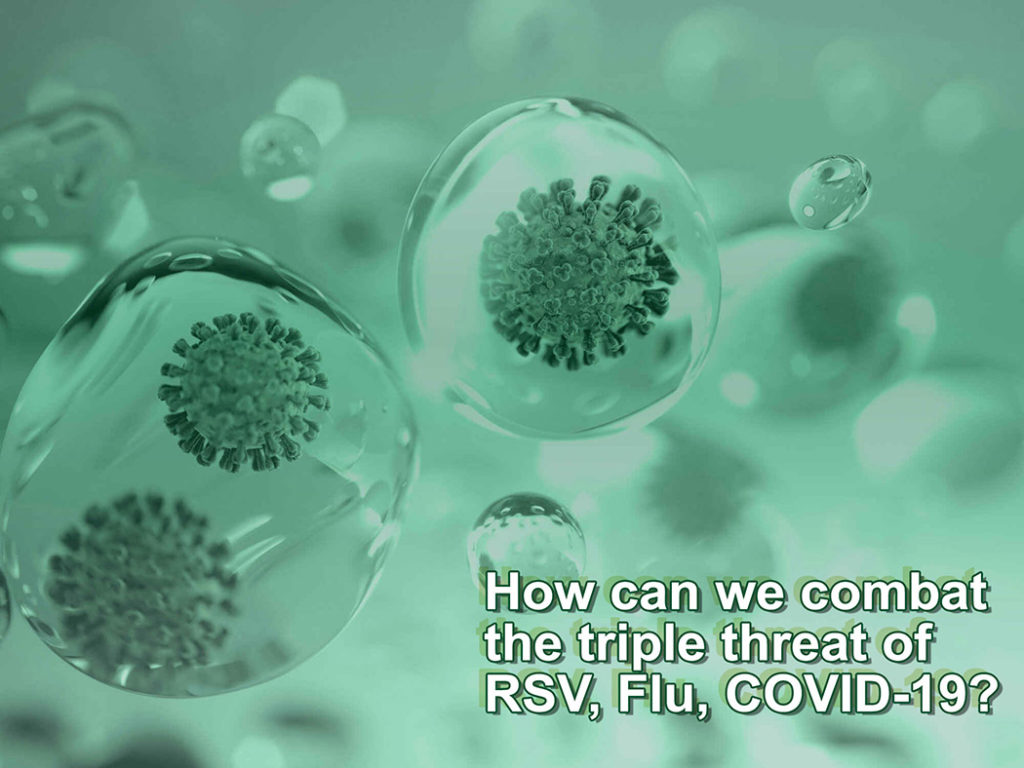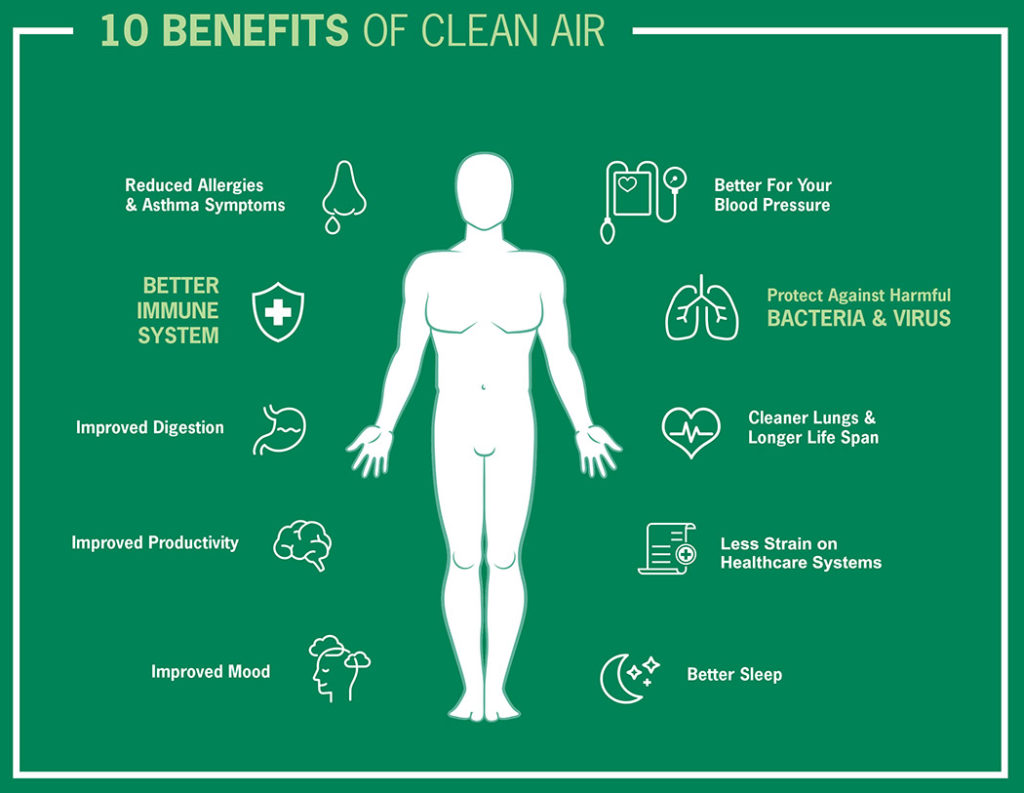How serious is the triple threat of RSV, COVID-19, and influenza in Canada this year? Respiratory syncytial virus (RSV), COVID-19, and influenza are creating major strains on Canadian healthcare systems. This is not only because of the spike in cases but also because the ongoing backlogs healthcare facilities are experiencing caused by the Pandemic are compounding problems. In this article, we discuss how Canadians can best protect themselves from the triple threat with a focus on indoor air quality.

Ontario has seen emergency room wait times of up to 45 hours for patients. Quebec has seen wait times of 48 hours and longer. British Columbia is seeing wait times of up to 10 hours. Alberta had wait times of just over 6 hours in some children’s hospitals. One of the worst things about epidemics and pandemics is the strain it puts on hospitals and medical clinics. Canadians have difficulty getting the healthcare they need in times like this.
It is believed that rates of RSV in children throughout Canada have skyrocketed because measures taken to prevent COVID-19 infection have resulted in less exposure to RSV during that time. Now, RSV is catching up quickly and children are more susceptible to the virus.
What are the health risks for people with RSV, COVID-19, and influenza?
RSV, COVID-19, and influenza can sometimes lead to the worsening of serious conditions such as congestive heart failure – when the heart can’t pump enough blood and oxygen through the body, Asthma – which causes breathing problems, especially among children, and Chronic Obstructive Pulmonary Disease (COPD) – a group of diseases that cause airflow blockage and breathing-related problems.
The CDC states, “Older adults who get very sick from respiratory illnesses may need to be hospitalised. Older adults are at greater risk than young adults for serious complications from respiratory illnesses because our immune systems weaken when we are older.“
How do respiratory viruses spread?
According to the Centers for Disease Control (CDC), respiratory viruses can spread when:
- An infected person coughs or sneezes
- Virus droplets from a cough or sneeze enter in your eyes, nose, or mouth
- Direct contact with viruses, like kissing the face of a child with RSV
- Touching a surface that has the virus on it and then touching a face before washing hands. *This is more apparent in RSV than with COVID-19 and influenza
While it is a good idea to keep surfaces sanitary, it should not be a primary focus. Microbiologist Emmanuel Goldman of Rutgers University states, “Despite public health guidance suggesting surfaces be disinfected to stop the spread of COVID-19, the virus wasn’t significantly transmitted through inanimate surfaces and objects, what microbiologists call ‘fomites.’ As with all respiratory viruses – from the flu to the common cold – transmission was and remains almost exclusively airborne.”
What are the differences between RSV, COVID-19, and influenza?
- RSV, influenza, and COVID-19 are all respiratory illnesses that have similar transmission mechanisms, but they are all genetically different
- RSV mainly affects young children, while COVID-19 mostly affects adults. According to the CDC, children are most likely to get sick from the flu and those aged 65 and older are least likely to get sick from the flu
- Unlike flu and RSV, COVID-19 can cause a loss of smell and taste
- It could take people with COVID longer from infection time to present with symptoms and they may be contagious for a longer period than with RSV and influenza
- Canadians 65+, those with weakened immune systems, chronic heart or lung diseases are at greater risk of hospitalisation from COVID-19, flu, and RSV
How can Canadians protect themselves from the triple threat of COVID-19, flu, and RSV?
To protect yourself and other Canadians from flu, COVID-19, or RSV, during waves of high transmission, cover your nose and mouth when you sneeze and cough, wash your hands often and keep your distance from people in public areas. Wearing a proper mask also reduces transmission. Using a high-quality air filter can remove a significant amount of harmful airborne particles indoors.
In the Lancet Respiratory Medicine Journal, Kevin P. Fennelly, MD states, “ Infectious aerosols are particles with potentially pathogenic viruses, bacteria, and fungi suspended in the air, which are subject to the same physical laws as other airborne particulate matter. It is easier for aerosol particles smaller than 5μm to stay airborne longer unless they are removed from the air through ventilation and filtration. These particles are easily transmissible through breath, sneezes, or coughs. They easily enter the lower respiratory tract.”
In high-transmission areas such as educational institutions, hospitals and clinics, recreational facilities, and public buildings, air filtration and ventilation can play a key role in reducing exposure rates.
To lessen the risk of airborne infection, ASHRAE’s Epidemic Task Force recommended a filter efficiency of at least MERV 13 (MERV 14 and higher would be better) for air recirculated by HVAC (Heating, ventilation, and air conditioning) systems and air purifiers. Core-recommendations-for-reducing-airborne-infectious-aerosol-exposure.pdf (ashrae.org)
Air filters can be labelled with both MERV and MERV-A values. When selecting MERV 13 or higher air filters, it is recommended to select filters with a MERV-A value when infectious disease risk mitigation is considered.
Many air purifiers contain HEPA filters which are among the most efficient filters available, up to 99.995% effective on the smallest particles. To ensure the filter is an actual HEPA, ask for the factory performance test when selecting an air purifier.
Air filters and air purifiers can help to protect against COVID-19, influenza, and respiratory syncytial virus (RSV) by trapping virus particles in the air filter or air purifier.
Vaccines can save lives and lessen the severity of COVID-19 and influenza
According to a study by The Lancet medical journal, millions of lives have been saved with COVID-19 vaccines worldwide. The CDC cites recent studies showing “flu vaccination reduces the risk of flu illness by between 40% and 60% among the overall population…”
RSV vaccines are still in the testing stages and one may become available in Canada next year. It can take several doses for immunity to build in babies and infants. However, if a pregnant mother is given the vaccine, the efficacy of the vaccine is much higher for the child and fewer doses are necessary.
Getting early treatment for COVID-19, RSV, or influenza can greatly reduce risks and severity. This is why testing and healthcare are important during this triple threat.
What can air filters and air purifiers do to reduce cases of RSV, COVID-19, and influenza?
Studies indicate droplets typically expelled by those suffering from respiratory infections range from 0.5 microns to a high of approximately 15 microns, with most in the lower size ranges.
Studies of other common viruses suggest droplets of 1.0 microns are capable of carrying enough viruses to cause infections.
Top Questions About Air Purifiers Answered by an HVAC Engineer
From a filtration expert’s point of view, a virus is generally contained within a respiratory droplet or aerosol making it the target particle that must be removed from the air. Camfil recommends filters with a minimum ISO16890 rating of ePM1 60% (MERV 13A) or higher.

STANDARD RISK AREAS
For standard risk areas such as commercial office and retail buildings, schools, airports, and manufacturing facilities, if the current configuration of the HVAC ventilation system allows, the efficiency recommended by ASHRAE is ePM1 60% (MERV 13A) or higher. To extend the service life, a prefilter with a minimum rating of ISO16890 ePM1-50% (MERV 8A) should be installed upstream if possible.
Camfil recommends:
Prefilter – 30/30® Dual 9 or other suitable prefilters
Followed by – Hi-Flo® ES or Durafil® ES3
HIGHER-RISK AREAS
It’s important to have a well-designed HVAC system in care facilities. In higher-risk areas, the minimum efficiency recommended is a 99.97% HEPA filter with appropriate prefiltration of lesser MERV value. Healthcare facilities should refer to ANSI/ASHRAE/ASHE Standard 170 for guidance on when this is needed. However, Standard 170 does not reference MERV-A-rated filters so it is recommended to select filters that comply with the minimum filter efficiencies of 170, but with MERV-A-rated filters.
Camfil recommends:
Prefilter – 30/30 Dual 9, Hi-Flo ES or Durafil ES3
Followed by – Absolute® VG, Filtra 2000®TM or XH Absolute®
EXISTING HVAC VENTILATION SYSTEMS
Some existing HVAC ventilation systems may not be configured for multiple-stage filtration or to withstand the higher pressure drop that comes with HEPA filters. As an alternative, consider adding a stand-alone room purifier with a minimum efficiency of H14, 99.995% on Most Penetrating Particle Size (MPPS).
It is highly recommended that you speak to an air filtration expert for all your needs. Click here to contact us
Sources:
Camfil North America
www.nlm.nih.gov
Centers for Disease Control
The Lancet Journal
Health Canada
BC Health, Alberta Health Services, Ontario Health, Health Quebec
